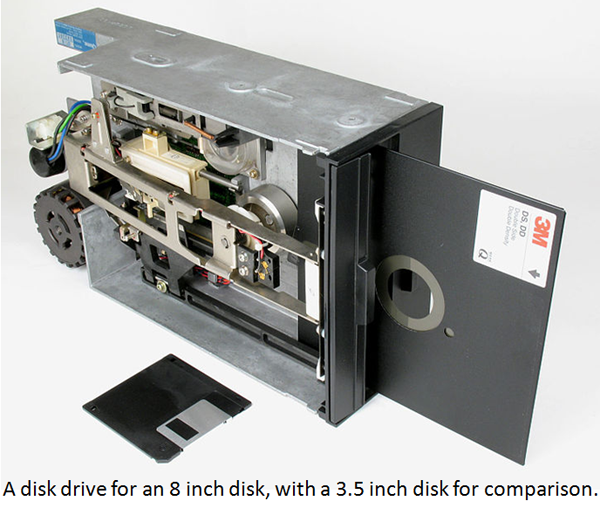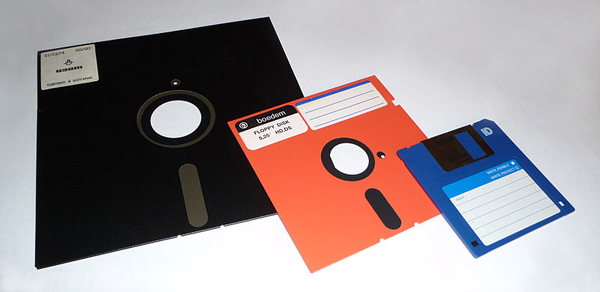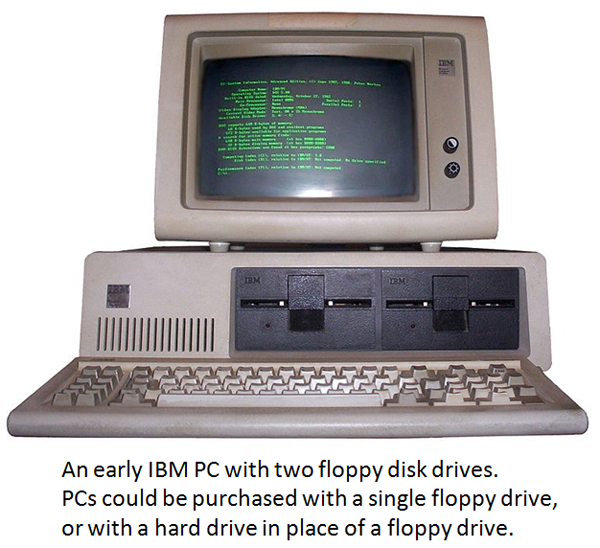The Death of the Floppy Disk
by Andrew Boyd
Today, floppy, but never a flop. The University of Houston's College of Engineering presents this series about the machines that make our civilization run, and the people whose ingenuity created them.
My wife and I purchased our first home computer in the mid nineteen-eighties. We were graduate students with a newborn son, and it freed us to type our dissertations in our apartment. I discovered that by crossing my legs in just the right way, I could cradle our son in my lap and gently rock him while I typed.
To save money, we prudently purchased a computer that didn't have an expensive option called a hard disk drive. Instead, it had one five-and-a-quarter inch floppy drive. It was slower and held about one-tenth of what the hard disks did at the time. But it was fine for our needs, and in addition to price, it had another big advantage over hard drives: it didn't wail like a circular saw.
[Early hard disk audio]
The five-and-a-quarter inch format was actually an advance over earlier versions that were a full eight inches on a side. Eight inches was just too big for the emerging personal computer market. But large and small, both formats shared a flaw. The disks were truly floppy. Housed in a thin plastic casing, they were easy to damage by folding. They also left part of the recordable disk area exposed to dust. Nothing destroys a disk drive faster than a screaming particle of dust crashing into a sensitive read/write head.
In spite of their limitations, five-and-a-quarter inch floppies became the de-facto standard for personal computers. Manufacturers experimented with other formats, but the ubiquity of five-and-a-quarter inch disks made them difficult to supplant.
That changed beginning in 1984. I first encountered the gripping new disk technology in the graduate student lounge. A friend arrived with an oddly shaped duffle bag and excitedly sat down next to me. Unzipping it, he reached in and pulled out the first portable computer I'd ever seen: an Apple Macintosh. Today we'd call it a luggable, but among its many features was a slot for a three-and-a-half inch floppy disk.

Actually, the new disk wasn't that floppy. Housed in a hard plastic case, it couldn't be inadvertently folded. And the recordable disk area wasn't exposed. It was protected from dust by a sliding metal plate. Best of all, the disk was designed to fit snuggly into the pocket of a men's sport shirt — at least when the pocket wasn't already crammed with an overstuffed pocket protector.

As important as they were, by the late nineties floppy disks were on their way out. Re-writable CDs were introduced that had the same capabilities as floppy disks but were more reliable. Many point to 2011 as the year the floppy disk died. That was when SONY stopped making them altogether. But we needn't cry for the floppy disk. It, after all, had been instrumental in killing off those giant reels of magnetic tape. The floppy disk was simply another useful technology whose time had come and gone.
I'm Andy Boyd at the University of Houston, where we're interested in the way inventive minds work.
Notes and references:
History of the Floppy Disk. From the Wikipedia website: https://en.wikipedia.org/wiki/History_of_the_floppy_disk. Accessed April 30, 2012.
C. Sorrel. Sony announces death of the floppy disk. From the Wired Magazine website: http://www.wired.com/gadgetlab/2010/04/sony-announces-the-death-of-the-floppy-disk/. Accessed April 30, 2012.
L. Ulanoff. The Floppy is Dead: Time to Move Memories to the Cloud. From the PC Magazine website: http://www.pcmag.com/article2/0,2817,2363055,00.asp. Accessed April 30, 2012.
All pictures are from Wikimedia Commons.
This episode was first aired on May 3, 2012
